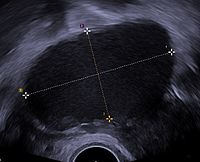
Photo from wikipedia
Abstract Endometrioma is the most common form of endometriosis and is a sign of wide-spread disease in symptomatic patients. Medical treatment options can be successful in endometrioma smaller than 1 cm,… Click to show full abstract
Abstract Endometrioma is the most common form of endometriosis and is a sign of wide-spread disease in symptomatic patients. Medical treatment options can be successful in endometrioma smaller than 1 cm, but ineffective for growing and symptomatic endometriomas. Conservative surgical interventions that preserve fertility, such as laparoscopic removal or destruction of endometriotic tissue or aspiration of cystic content are typically used to treat the condition. One of the most frustrating aspects of endometrioma treatment is disease recurrence. The underlying mechanisms explaining recurrence are uncertain. Several risk factors have been evaluated in order to predict recurrence after cystectomy. In looking at the results overall, our study can conclude that the presence of greater cyst dimension, higher CA-125 level, presence of preoperative symptoms of non-cyclic pelvic pain, dysmenorrhoea and adhesion extension may be associated with recurrent endometrioma. In clinical practice, identification of risk factors for recurrence helps clinicians to inform patients. Impact statement What is already known on this subject: Endometrioma is the most common form of endometriosis and is a sign of wide-spread disease in symptomatic patients. One of the most frustrating aspects of endometrioma treatment is disease recurrence. Several risk factors have been evaluated in order to predict recurrence after cystectomy. However, the risk factors have not been precisely defined. What the results of this study add: This study aimed to investigate the contribution of possible risk factors to the recurrence of endometrioma after laparoscopic surgery. In looking at the results overall, our study can conclude that the presence of greater cyst dimension, higher CA-125 level, adhesion extension, presence of preoperative symptoms of non-cyclic pelvic pain and dysmenorrhoea may be associated with recurrent endometrioma. What the implications of these findings are for clinical practice and/or further research: In clinical practice, identification of risk factors for recurrence helps clinicians to inform patients. Detection of preoperative risk factors would be helpful in counselling patients on their future prognosis. This may also increase treatment success by providing accurate preoperative treatment planning and by assisting the scheduling of postoperative follow-ups.
Journal Title: Journal of Obstetrics and Gynaecology
Year Published: 2018
Link to full text (if available)
Share on Social Media: Sign Up to like & get
recommendations!